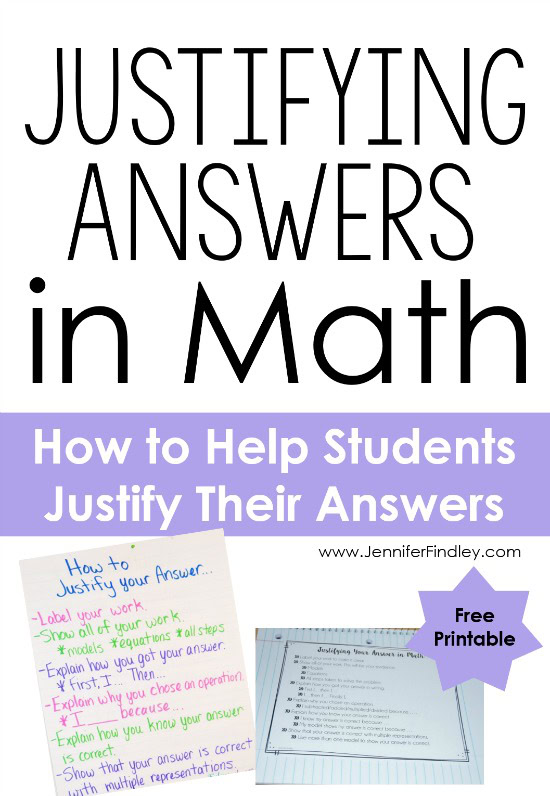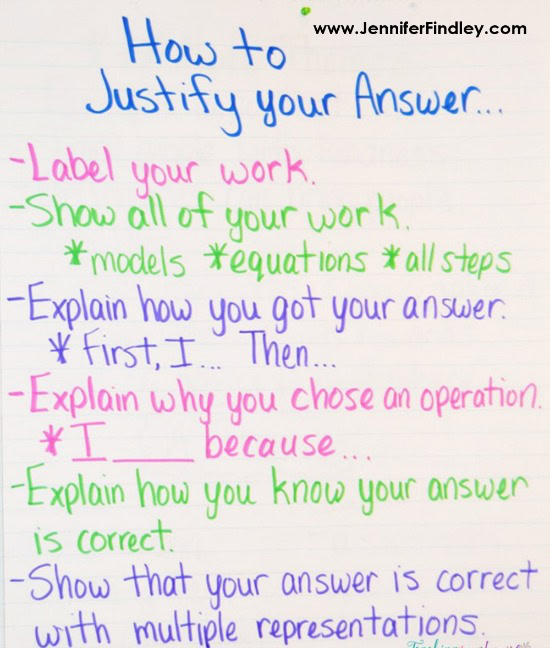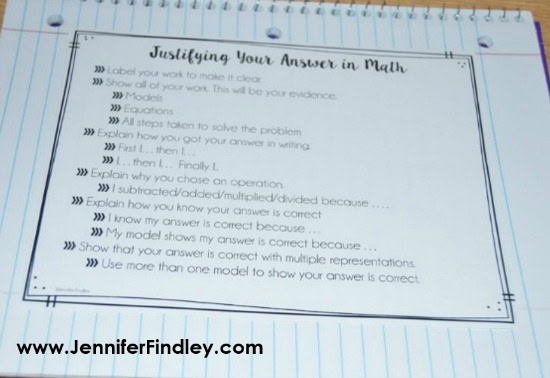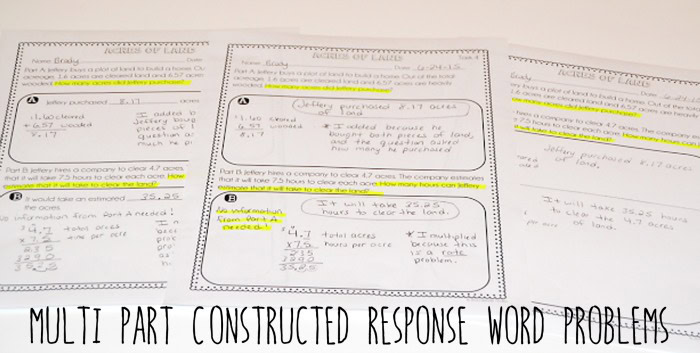Teaching students to justify their answer in math can be difficult, but thankfully it doesn’t have to be. I want to share with you some ideas for teaching students how to justify answers in math, as well as some of my favorite resources for providing much needed practice with math tasks and word problems.

1. Create an anchor chart with clear examples and your expectations for how you want your students to justify their answers.
Any time my students are struggling with something, I like to take a close look at what they are struggling with to see if I can break it down and make it very clear for them. In regard to teaching students how to justify answers, I tried to think of all the ways students could justify their work. Here is the anchor chart that shows some of the ways my students can and have justified their answers in the past. I suggest you have in mind what you are looking for, but have a discussion from the students and get their input as well. The best scenario would be creating the chart together and having the students “help” you come up with the different ways they can justify their answers.
 I know the first one on this chart (labeling your work) doesn’t technically help justify their answer, but it definitely helps them stay organized and focused. We also talk about how showing all of your work is key to the justification process. For the past two years, I have had more and more students who erase their math work after finding the answer. It blew my mind when I kept seeing them do it over and over, and it took about a month for me to break them of the habit. I always tell them their work is just as important as their answer and their explanation.
I know the first one on this chart (labeling your work) doesn’t technically help justify their answer, but it definitely helps them stay organized and focused. We also talk about how showing all of your work is key to the justification process. For the past two years, I have had more and more students who erase their math work after finding the answer. It blew my mind when I kept seeing them do it over and over, and it took about a month for me to break them of the habit. I always tell them their work is just as important as their answer and their explanation.
Speaking of explaining, I also like to be very deliberate about teaching them how to explain their answer. As you can see from the chart, I show them how to explain how they got their answer, how they chose a particular operation, and how they know their answer is correct. I like to give students sentence stems whenever I can to help scaffold them as well. And finally, I try to push multiple representations to get the students to justify their answer in a variety of ways.
2. Give the students a reference tool to refer back to when solving math tasks.
After completing this chart with my students, I like to give them a printable version that they can glue in their interactive notebooks and refer back to as they solve math problems and tasks on their own. It particularly helps my students when they have a clear list they can look over to ensure they have justified their work.
 To grab the free printable shown above, click on the image below.
To grab the free printable shown above, click on the image below.
3. Provide multiple opportunities for students to practice justifying their answers.
After you have provided clear expectations for your students to follow, the next step is to provide multiple opportunities for them to practice justifying their answers. If you are looking for resources to use to provide practice for your students, here are a few of my favorites.
Differentiated Multi Part Constructed Response Math Tasks: This resource focuses on multi part constructed math tasks that are differentiated and separated by skill. The response section of each task (not the tasks itself) is differentiated at three levels to help students organize their answers and justifications effectively. Click here to grab a freebie to try out on this post or see them in my TpT store by clicking here.
Word Problems for Interactive Math Notebooks: This next one is a student favorite, as well as teacher favorite. My students always love math interactive notebooks. Keeping this in mind, I created a set of interactive math notebook word problems for each of the common core math standards. To read a detailed post about this resource, click here. The students love these because they get to color in the graphics when they are completed, and they are half page which makes them less threatening. I love them because they are stored in their notebook for students to refer back to throughout the year. Click here to see the fourth grade version. Check out the fifth grade version by clicking here.
Constructed Response Math Tasks: I also use standards based constructed response math tasks on a regular basis throughout the year so my students have lots of opportunity to practice justifying and explaining their answers. By doing these throughout the year (about once every two weeks or so), my students become pros at this. The state test at the end of the year is just an extension of all the work they have been doing throughout the year. I typically use these as more of an assessment than the other two examples of resources I shared above. Click on the grade level you want to see in my TeachersPayTeachers store to see more. Also, there are freebies in the previews of each grade level so you can try these out with your students!
How do you help your students become proficient with solving word problems and justifying their answers?











Thanks so much for this post!!
I have the word problems for Interactive Notebooks, and used the last year and this.
This post with the justifications will help tremendously!!! 🙂
THANKS!!
This is a great resource! And it can be used for a variety of grade levels. I really appreciate this…it will be great as we prepare for testing in the spring!
I love your resources. Any ideas for 3rd grade? or who sells the best constructed response packs?
Need help to save my rising 6th grader.
I’m actually in college, and this is great to get kids learning how to do these things young! I actually used this to help me through my calculus intensive physics labs…it helped me really be able to organize and justify things in a comprehensive manner. So, you helped a college student! Thanks!
This is ridiculous and cruel to have children justify and explain their math nowadays!
And in 3rd grade they’re now getting marked wrong for correct answers on their math tests because they didn’t put a Label or write their own Word Story Problems next to their solved multiplication and division answers! None of us ever had to do any of this nonsense when we were younger and we’re all fine! Children born today are NO different than children born generations before them! They are children! Not machines! The old way of American public school learning served many generations just fine because it was the BEST! It seems Common Core/PARCC CRAP brought this on with their new crazy backwards math and doing word problems at younger ages even in first grade now! In 3rd they’re now also having to write their own word story problems on top of this! And they now have to explain every darn thing in their new language art classes and use R.A.C.E. to restate, answer, cite and explain their classwork story reading paragraphs, instead of reading the story and answering questions they now have to use R.A.C.E.for each paragraph (passage). And they have to explain their math equations, and rheir word problems so young! All thanks to Common Core and anything else like it being pushed on our public school aged children in recent years! Teachers don’t teach anymore! Instead they’re dictated to go by the Standards books! And kids gave to answer word for word by the Standards books, even though that is impssible as they have their own brains and minds! Bet this doesn’t happen in the elite private schools that Gates, Obama. Pearson, etc. children attend or have attended! Remember children in school are kids, including those in high school! Let them live their childhoods!
Hi Tam, it is frustrating and I am 100% in agreement that a lot of the requirements are not developmentally appropriate, too critical, and often nit-picky. To clarify, I would never require my students to justify every answer they give. However, the ability to justify and explain answers is a powerful tool to develop in all of our students. The ability to think about math in this way is what really helps our students have a deep understanding of math and allows them to compete with the students in those elite private schools you mention. However, with everything a balance is needed.